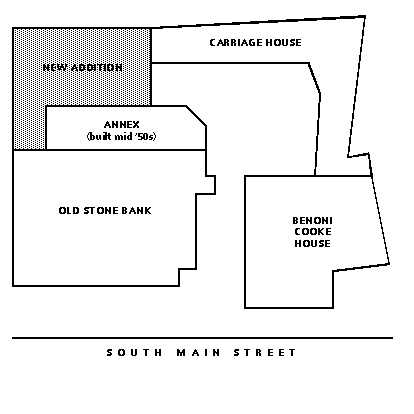
The Brown University News Bureau
38 Brown Street / Box R
Providence, RI 02912
401 / 863-2476
Fax: 401 / 863-9595
1995-1996 index
Brown buys Old Stone Bank building to house the Haffenreffer Museum
The gold-domed bank building, a fixture of the Providence cityscape since the turn of the century, will be the centerpiece of a facility that will provide galleries, storage areas, offices, public education space and a bookstore for the Haffenreffer Museum of Anthropology, currently housed on the University's Mount Hope grant in Bristol, R.I. Brown will seek funding for nearly $12 million in acquisition, restoration, renovation and new construction and will begin a public fund-raising project next year. The University has given itself three years to raise the funds and undertake the renovation and construction needed to bring the museum to Providence.
"It is our ardent hope that moving the museum to the Old Stone property will involve the University more deeply in the cultural and economic life of downtown Providence," Gregorian said. "The city's rich ethnic and cultural diversity makes Providence an appropriate permanent home for the Haffenreffer's collections, and the museum's long-standing commitment to education and outreach will make the Old Stone site a great asset for Providence schools. I am delighted that this exciting project is moving forward."
"Brown is establishing a presence downtown, and I am excited about the myriad opportunities that the Haffenreffer will offer in its new location in our capital city," Cianci said. "Once the museum opens in the Old Stone Bank building, the boundaries of our terrific Arts and Entertainment District will expand, adding a unique, eclectic and educational dimension for residents and tourists to explore. The resurgence of downtown Providence is based upon our ability to blend our resplendent past with bold, new ventures, and the Haffenreffer Museum is representative of each. It's a plus for Providence, and I welcome Brown's investment in our city."
The move to downtown Providence will have significant benefits for both the museum and the city. Although the museum hosts as many as 6,000 schoolchildren and 9,000 other visitors per year, its remote location in Bristol - 18 miles from Providence - limits accessibility. The museum's collections outgrew the current facility long ago, so that only a fraction of its 100,000 artifacts can be displayed at any one time. The Old Stone site will allow the museum to make more of its collections available to a much larger audience, particularly Providence schoolchildren.
The move will also benefit downtown Providence by securing the future of a magnificent historic "signature" building and by adding a nationally renowned museum to the city's growing arts and entertainment district. Several other significant museums and cultural centers will be coming to Providence, including the Children's Museum of Rhode Island and the new Rhode Island Heritage Center, to be established on the former site of the South Street electric station, which will be home to a dozen museums. The relocation of the Haffenreffer Museum has drawn praise from business, civic and restoration groups.
"Brown's decision to acquire these historic buildings will help breathe new life into the heart of the city and bolster Providence and Rhode Island as major cultural and tourist destinations," said Lawrence K. Fish, chairman and chief executive officer of Citizens Financial Group Inc. Citizens purchased the deposits of the failed Old Stone Bank from the government in 1994 and has worked with the RTC over the last year to ensure the appropriate care and reuse of the historic gold dome building, Citizens officials said.
In addition to the gold-domed building, the Old Stone site includes other historic structures. The Benoni Cooke House, a large Federal-style residence built in 1828, served as an office and branch bank for the Providence Institute for Savings (later the Old Stone Bank). Its first floor has been substantially modernized, and a "greenhouse" style addition was added to the first floor west facade in 1982.
The Old Stone Bank building and the Benoni Cooke House are in generally good condition with some water damage to the interior of the bank, according to Ann Beha Associates Inc., a Boston architectural firm specializing in historic preservation, which has been the University's primary consultant for the project. The site also includes a carriage house, which is in poor condition and will require substantial rebuilding.
The Benoni Cooke House and the Old Stone Bank building are located within a National Register District and the College Hill Historic District, designated by the Providence Historic District Commission. They entered the RTC's conservatorship program in January 1993 and entered receivership in July 1994. Brown has been working on a negotiated sale with RTC for the last 10 months.
After the sale has become final, the University will conduct a design competition to select an architect to oversee renovation and new construction. In addition, Gregorian will appoint an advisory committee of local and national experts to advise the University on the renovation of the site and relocation of the Haffenreffer Museum.

Among the 100,000 objects in its collections, the Haffenreffer Museum has cataloged several major ethnographic collections:
"The Haffenreffer Museum of Anthropology is one of Rhode Island's best-kept secrets," said Shepard Krech III, the Haffenreffer's director. "It is a museum for all people, with collections that speak to the heritage of many different ethnic groups. In Providence, the museum will build on its strengths, quickly expanding its ties to the public through enhanced education and outreach programs and more visible exhibitions. Moving to South Main Street offers advantages to the museum, the city and the University that are almost incalculable."
###### 95/005Other documents available from the Brown News Bureau
95-005a - Background on the Haffenreffer Museum and collections 95-005b - Statements from community leaders and organizations
Other documents
Watercolor renditions and an original architectural cross-sectional drawing are part of the collection of the Rhode Island Historical Society, 401/331-8575.